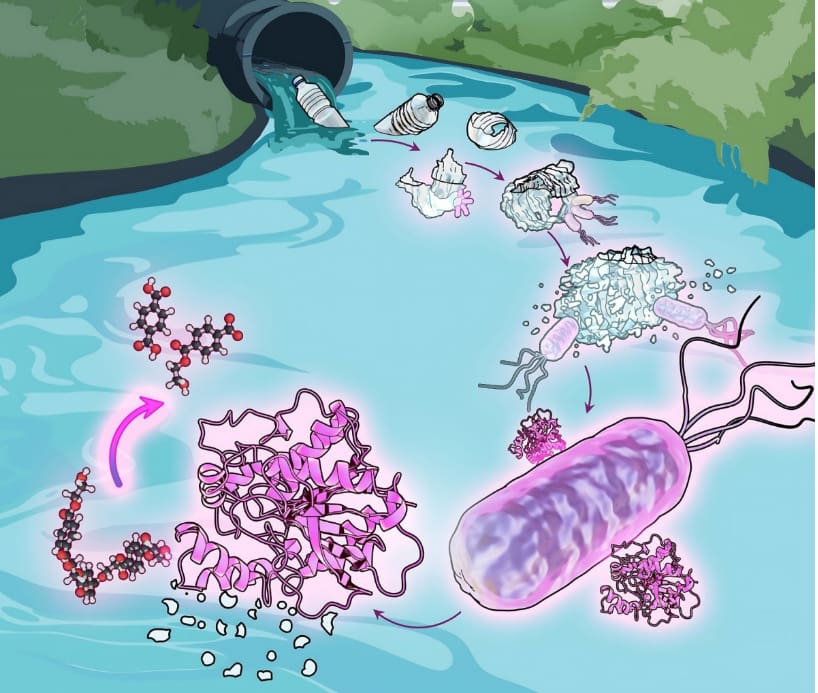
Plastic Eating Bacteria and Microbes: A Potential Solution Towards Environment Sustainability

Image Credits: Comamonas bacteria live in wastewater, where they break down plastic waste for food. Credit: Ludmilla Aristilde/Northwestern University, (https://scitechdaily.com/plastic-eating-bacteria-discovered-in-urban-waterways)
The fossil fuel and petrochemical resources based plastic products are being widely produced and applied in various sectors e.g. packaging, automobile, agriculture, construction and building, medical, aircraft, aerospace etc. at large scale since last three decades. Their global output has already reached more than 400 Mt per year by 2020 and is expected to reach up to 800 Mt and 1600 Mt by 2035 and 2050, respectively.
But production and consumption of plastic products of Polyolefins (LDPE, HDPE, LLDPE, PP etc.), PVC, Polystyrene, PET etc. at massive level have raised very serious concern imparting a negative effect on human health and the environment resulting into troubledness for environment sustainability. Plastic films of low thickness (below 50 micron), single use products and other products which are not taken at recycling centres, have created a major concern for waste management, environment and sustainability.
To overcome this issue, the scientific communities and researchers and environment protection bodies are also putting their efforts to find out the microorganism-based solutions for synthetic plastics apart from recycling techniques. Various species of bacteria, algae, fungi and microbes have been tried to study their affinity towards hydrocarbons chains of high molecular weight and bond strength. Bacteria and other microbes in optimum culture and growing conditions are interacted with plastics so that by secretion of favourable enzymes to break the -C-C, -C-H, -C=O and -C-O-C bonds for their digestion, carbon and energy sources. So far, scientists have identified more than 100 bacterial species with the potential ability to weaken plastic’s chemical bonds having high bond dissociation energy. However, PET plastic products have been studied successfully for an interaction with bacteria; Ideonella sakaiensis, known for their breaking down and digestion.
The most positive information i.e. increasing an affinity exposure of PE with algae, fungi, and bacteria. Several researchers have found that microorganism degradation of plastic can be a promising solution for white pollution. From the study, it has been observed that Achroia grisella from wax-worm larva consumes LDPE hydrocarbon chains a sole diet in optimum and favourable conditions.
Various bacterial strains Bacillus spp., Streptococcus sp. etc.), fungal strains (e.g. Aspergillus spp., and Penicillium spp.) and algal strains (Anabaena spiroides, Nostoc carneum, Oscillatoria subbrevis, and Scenedesmus dimorphus) have shown a degradation activity against PE biodegradation. Several invertebrates such as land snail (Achatina fulica), superworms (Zophobas atratus), waxworms (Plodia interpunctella), and other invertebrates have been shown an ability to degrade several types of synthetic plastics such as LDPE, HDPE, PP, PVC, PET and Polyamide.
This Blog by Dr. Bhuwanesh sharma, Asst. Professor, School of Engineering, Plastindia International University.
Similar Posts:

The Importance of Professional Communication and Soft Skills for Engineering Students

The Blending of Mathematics and Polymers in Shaping the Future of Plastics

Innovations and Developments in Plastics and Polymer Engineering – Shaping the Future

The Importance of Simulation in the Plastics and Polymer Engineering Sector

The Journey of Polly the Plastic Bead: A Tale of Plastic Engineering

PLASTICS: A MULTIDISCIPLINARY INDUSTRY

Plastics: Play a Crucial Role as Life Saving Material in Modern Healthcare, Food Packaging and Daily Life

Modern Plastics: Circular Economy and Sustainability

Circular Economy in the Indian Plastics Industry: A Path Towards Sustainability

The Future of Plastics: The Integral Role of Computer Science Engineering

From Waste to Wealth: Innovations in Plastic Recycling

From Classroom to Industry: Exploring Careers in Plastics Engineering

Speciality Polymers in Industry: Transforming the Future

The role of Plastic and Polymer Graduates in the Plastic molding industry

PIU and the Future of Plastics: A UMass Lowell Legacy of Innovation

Plastics: Pioneering Invention to Sustainable Innovations

An Engineer’s perspective on Plastics: Beyond Buckets and Mugs

Sustainable Edge of Plastics in Modern Life
